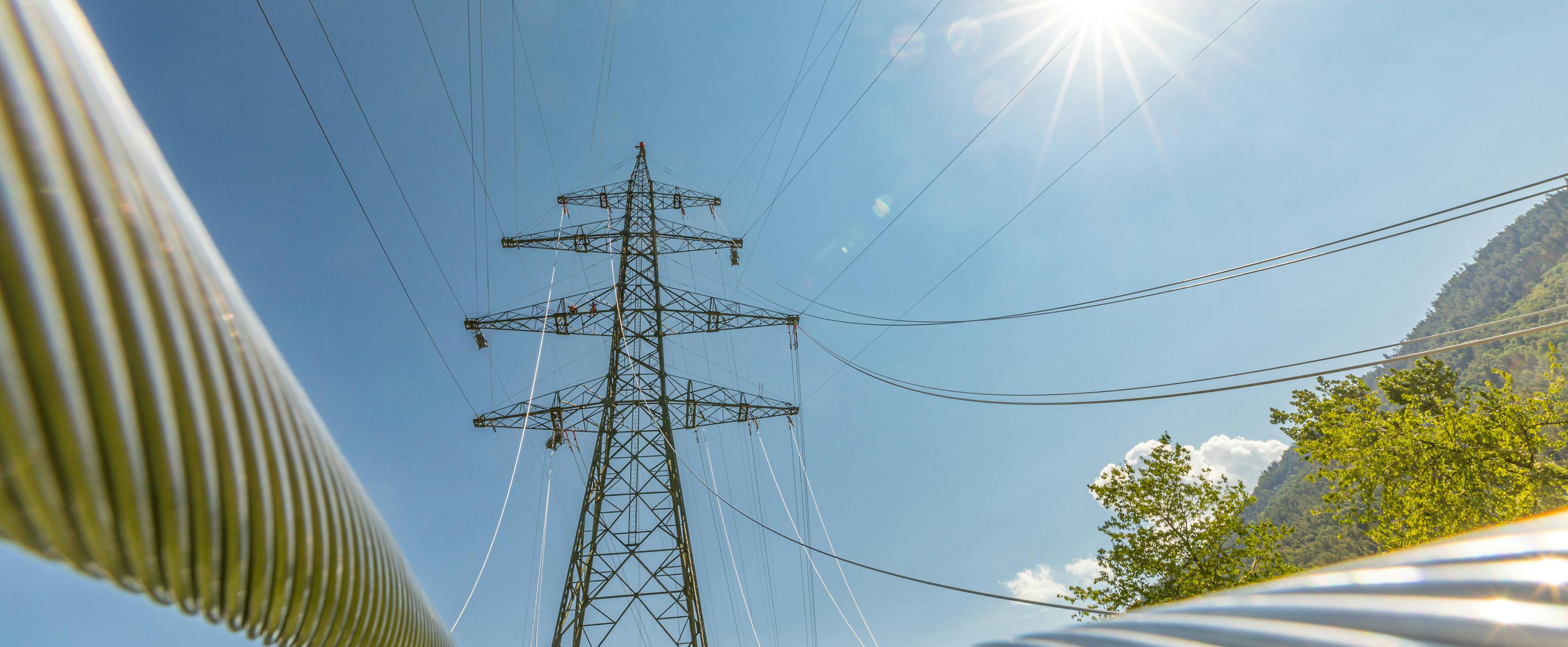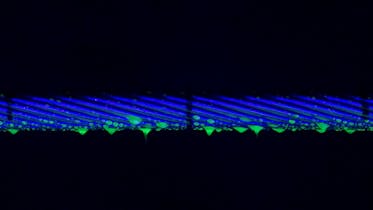
A walk is especially pleasant after it’s been raining. Everything shines in the light of the sun and looks freshly washed. Anyone who has ever walked under an extra-high-voltage line at this very moment may have already noticed a crackling, humming sound coming from the line. But why do you only hear these noises at certain times, and why are they not always equally loud? To answer these questions, we need to understand how the sounds are created in the first place.
Electric fields as a cause of noise
As soon as an extra-high-voltage line is energized, it becomes live, even if no current is flowing along it. This creates an electric field. The same thing happens when we plug an appliance into a power outlet in our homes. Even if it remains switched off, an electric field is created by the voltage. But going back to the extra-high-voltage line, the electric field is very strong right next to the conductors and then decreases rapidly the further away from them you go. If there are protrusions on the conductor, such as water droplets, the field can locally become stronger. This strong field can cause electrical discharges to develop. These corona discharges lead to the perceptible noises that can be described as crackling or humming.
The noises we hear when we go out for a walk after it’s been raining have nothing to do with the load of the line. They always occur when the line is in operation and there are water droplets on the conductors. Instead of water droplets, pollen or other contaminants can also trigger corona discharges.
Corona discharges may therefore be due to pollen or raindrops on the conductor, caused by the electric field, which in turn depends on the voltage. The greater the voltage, the stronger the electric field. This is why noise occurs more frequently on 380-kilovolt lines than on 220-kilovolt lines or distribution system lines. But how can these noises be reduced?
The older the conductor, the less noise there is
A new conductor is louder than a used one. This sounds paradoxical at first, but it has nothing to do with more recent material being of inferior quality. Conductors consist of smooth aluminium wires. When they are new, they are very water repellent. Large numbers of droplets form on water-repellent surfaces, such as on the material used for raincoats. The situation is different with a water-attracting surface like a pair of jeans. A film of water develops on it and there are virtually no water droplets. The older and more weathered a conductor, the more its surface attracts water. And since fewer droplets form, there is also less noise.
What can be done to ensure that new conductors do not make too much noise? In the vicinity of residential areas, new conductors can be used that have either been coated with a special water-attracting paint or treated with technical processes (such as sandblasting) so that they attract water. Conductors that have been treated in this way are matt rather than shiny.
The thicker the conductor, the quieter the noise
The greater the cross section of a conductor, the lower the electric field. This is attributable to the larger surface area of the conductor. In other words, the thicker a conductor, the fewer corona discharges it produces, and therefore the lower the noise. The electric field at the surface of the conductor can also be reduced by using several conductors instead of just one. For this reason, multiple conductors are often used per phase on extra-high-voltage lines. They can only be seen when looking carefully at the lines right next to them because the conductors are so close to each other. But why not simply hang more or thicker conductors on the pylons, and the problem would be solved? The thicker the conductor, the heavier it is. The weight of the conductors is borne by the pylons. If there are large numbers of conductors or a thicker type is used, stronger pylons with more steel are needed. As well as incurring higher material costs, a more sturdy pylon is also more visible and cannot be integrated into the landscape as effectively.
However, a larger cross section of conductor has a second advantage in addition to producing less noise: it results in fewer transmission losses. In summary, it is clear that many factors play a role. As is often the case, it is a question of finding the best possible compromise between noise, transmission losses, steel requirements, costs, visibility and other factors.
Gaining new insights
ETH Zurich is conducting research into more precise measurements and calculations of the corona discharges responsible for noise. This involves taking measurements in real conditions, for example at the outdoor test facility in Däniken. Different parameters such as the electric field and the loss current caused by the corona discharges are measured in different weather conditions, and the meteorological parameters are noted. The aim is to gain a better understanding of the conditions in which corona discharges occur in order to predict noise generation more precisely. More accurate modelling of the noise will allow better planning in the future to determine where noise reduction measures are necessary and where which type of conductors should be used. Conductors with innovative surface treatments are examined under a rain simulator in the laboratory to compare them with each other and to see which surface treatment produces the fewest raindrops. The findings of ETH Zurich help Swissgrid to select conductors for new lines and to predict noise development. This ensures that the limits are complied with at all times.









